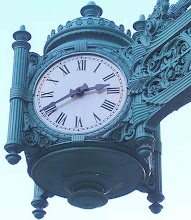Treasures uncovered from the 1975 Marshall Field's Christmas catalog:

First, the ooh and aahs. In honor of the upcoming Bicentennial, a small assortment of honest-to-goodness antiques. A $5,000 pewter plate made by William Will, $5,000. A pewter porringer by Frederick Bassett, one of the few extent pieces, $4,500. In the upper left, an autographed signed letter from John Jay, $12,500. Belowit, an autographed letter from George Washington, $8,500. Those are 1975 prices, folks.


Guaranteed never to be seen in fashion again: Coordinating his-n-hers denim leisure outfits:

The more independent man might choose to go his own way in a Mighty-Mac (yes, that's the brand for the blue number below) leisure suit.
 Never again will cotton corduroy fancy painter paints be so fashionable:
Never again will cotton corduroy fancy painter paints be so fashionable: Before engineered basketball shoes and high-fashion sneakers took over, everyone wore Treton tennis shoes. I remember agonizing over which color to get:
Before engineered basketball shoes and high-fashion sneakers took over, everyone wore Treton tennis shoes. I remember agonizing over which color to get:
 Nothing says 1970s Christmas like these: a patchwork tree skirt, gingham quilted stocking, corn husk mice, pine cone wreath, and handwoven Christmas tree wall hanging from Colombia.
Nothing says 1970s Christmas like these: a patchwork tree skirt, gingham quilted stocking, corn husk mice, pine cone wreath, and handwoven Christmas tree wall hanging from Colombia.I so much remember this red-and-white logo, covering Christmas boxes that got used and over and over because they were so thick and sturdy.

The first page has dolls, including -- woo-hoo -- Madam Alexander dolls. The set of 5 were the Little Women plus Marmee. My sister had all four. I never understood why Marmee was the same size as her children. We spent hours playing with these. Then the basement flooded several feet and Beth, alas, suffered from an incurable case of mold and bad hairstyling for the rest of her existence.
My sister also had the Scarlett O'Hara doll. With a green belt. When I saw the movie and noticed her belt was really red, I was incensed, because clearly the movie got it wrong. Little did I know that this doll cost $19.95. That's $95.27 in 2009. At least we loved her to death. As far as I know, her underwear, tights, and shoes came off immediately upon arrival home and were never seen again.

Ah, some groovy 70s craft kits. Here they are, all in one place. Let's play I Spy. Can you spy: the candy-making kit? the macrame kit? the batik kit? the incense making it? the 3-D string art kit? the woodburning kit? What the happy puppy sniffing a flower is doing in the upper left corner I have no idea.
 I can't believe it -- it's an actual Big Wheel, complete with "rakish low-slung suspension" for stability. A bargain at $12.95 (or maybe not, that about $50 today). But worth every penny.
I can't believe it -- it's an actual Big Wheel, complete with "rakish low-slung suspension" for stability. A bargain at $12.95 (or maybe not, that about $50 today). But worth every penny.I throw this one in because every girl I knew had one of these rustic cedar log cabins. They always got smelly and fully of decaying trees after a year.
I would have much preferred those adjustable Satellite jump shoes for realistic moon-walking. Another one just thrown in because I recognize it -- in this case, because I had it: Paint 'N Peel. Absolutely no point except to draw a picture in paint, let it dry and then peel it off. I think I tried eating one once.
Another one just thrown in because I recognize it -- in this case, because I had it: Paint 'N Peel. Absolutely no point except to draw a picture in paint, let it dry and then peel it off. I think I tried eating one once.
 Another one just thrown in because I recognize it -- in this case, because I had it: Paint 'N Peel. Absolutely no point except to draw a picture in paint, let it dry and then peel it off. I think I tried eating one once.
Another one just thrown in because I recognize it -- in this case, because I had it: Paint 'N Peel. Absolutely no point except to draw a picture in paint, let it dry and then peel it off. I think I tried eating one once.
You don't realize how far electronics have come until you see the electronic toys of 1973. A four-transistor Marfield (ha! Marshall Field's made!) walkie-talkie with a one-block range and groovy brick-size stylin. But really ... a crystal radio kit? A telegraph signal system? You'd think these toys were made by old men who grew up in the 20s. Oh, wait ...
This stuff reminds me of a time I went into a museum and saw a Winnebago RV toy I'd owned as child. It was just an incredible thrill. There's the nostalgia of course. But it's something more. That odd realization when you notice that something that was incredibly familiar and a part of your everyday life had disappeared. And been gone for years. So long that it had become unfamiliar, but familar at the same time.
Looking at this catalogis is like suddenly encountering your past self, someone you totally know and recognize but don't recognize as yourself anymore. Funny how history works that way.









